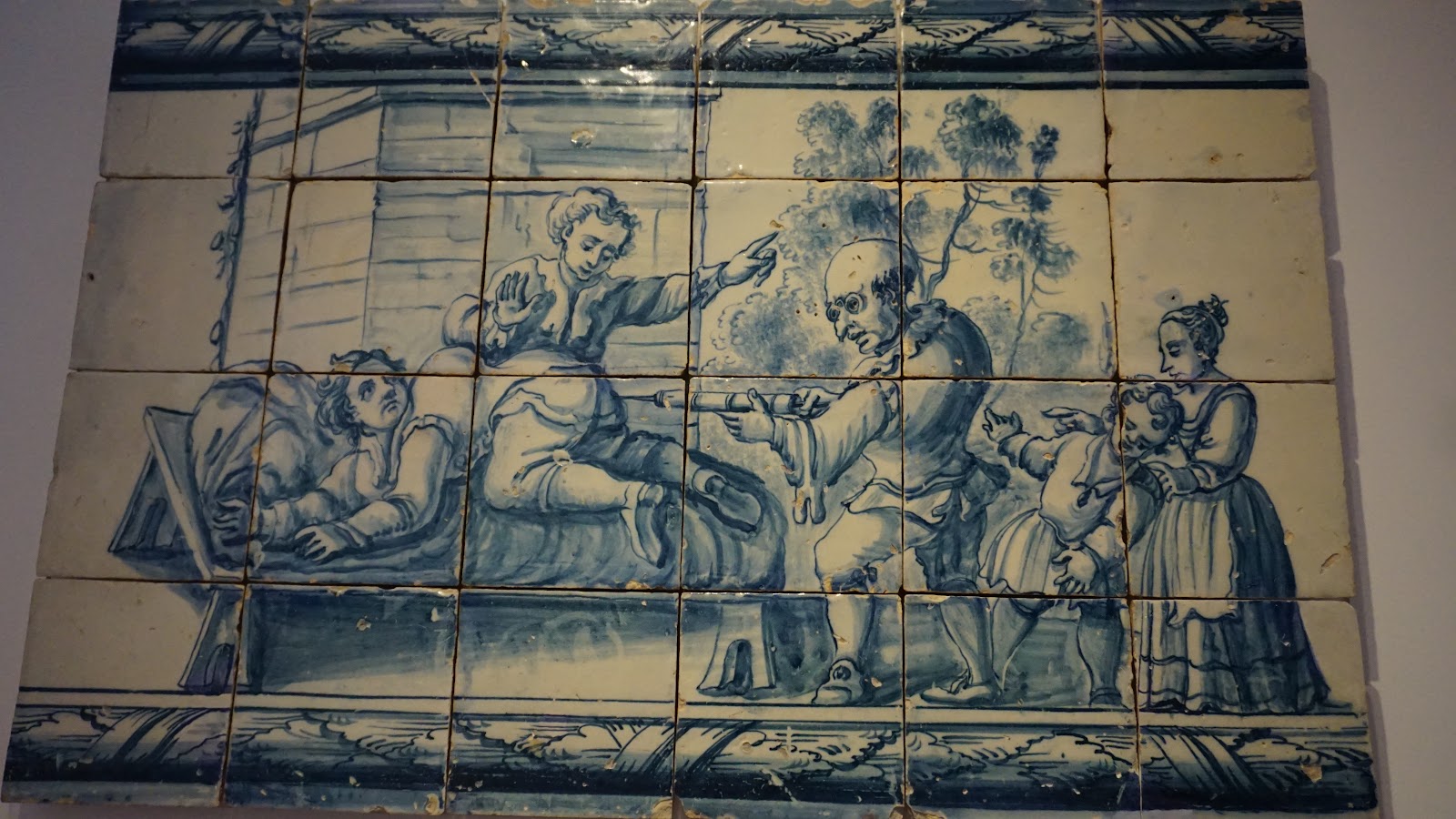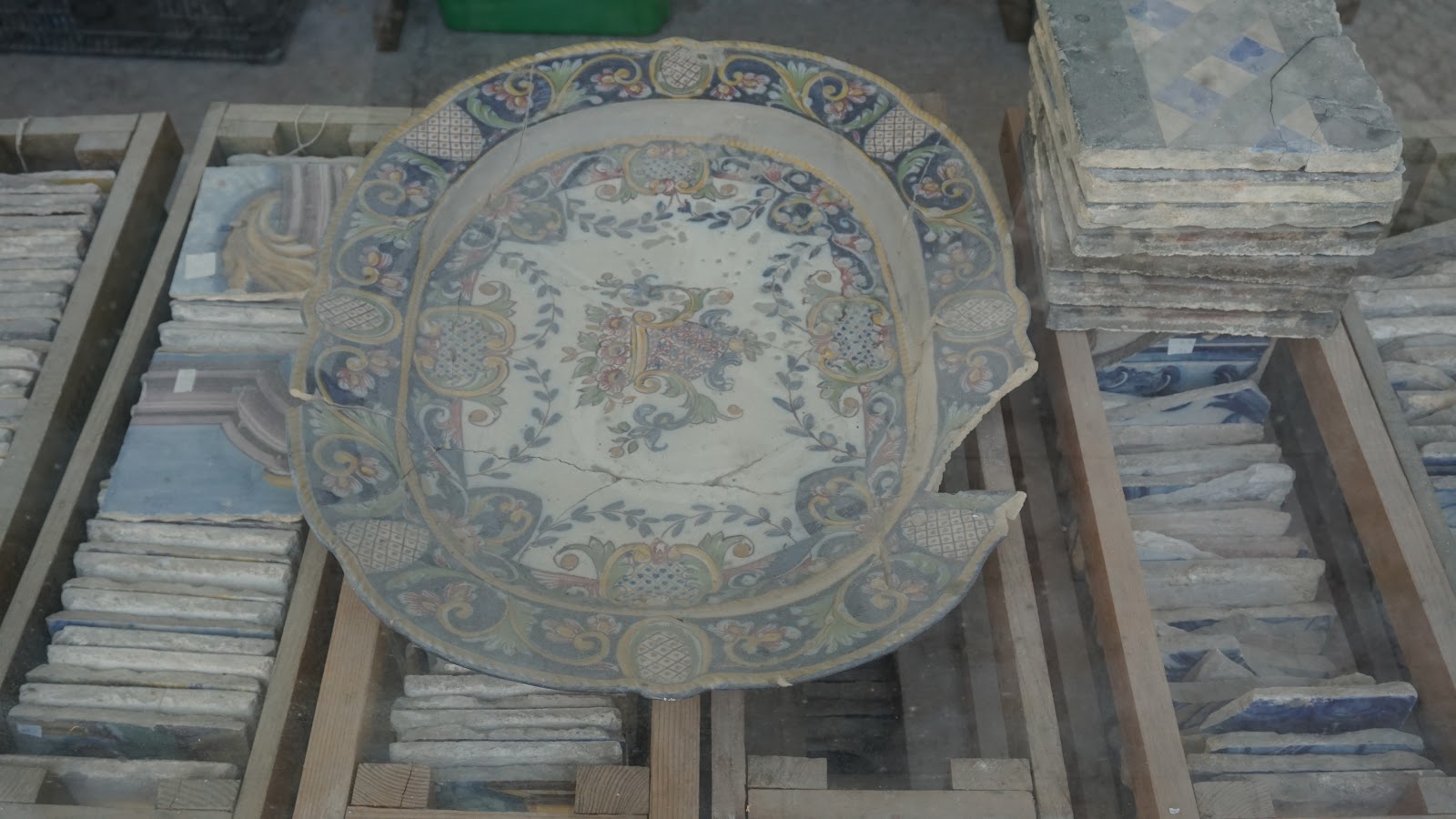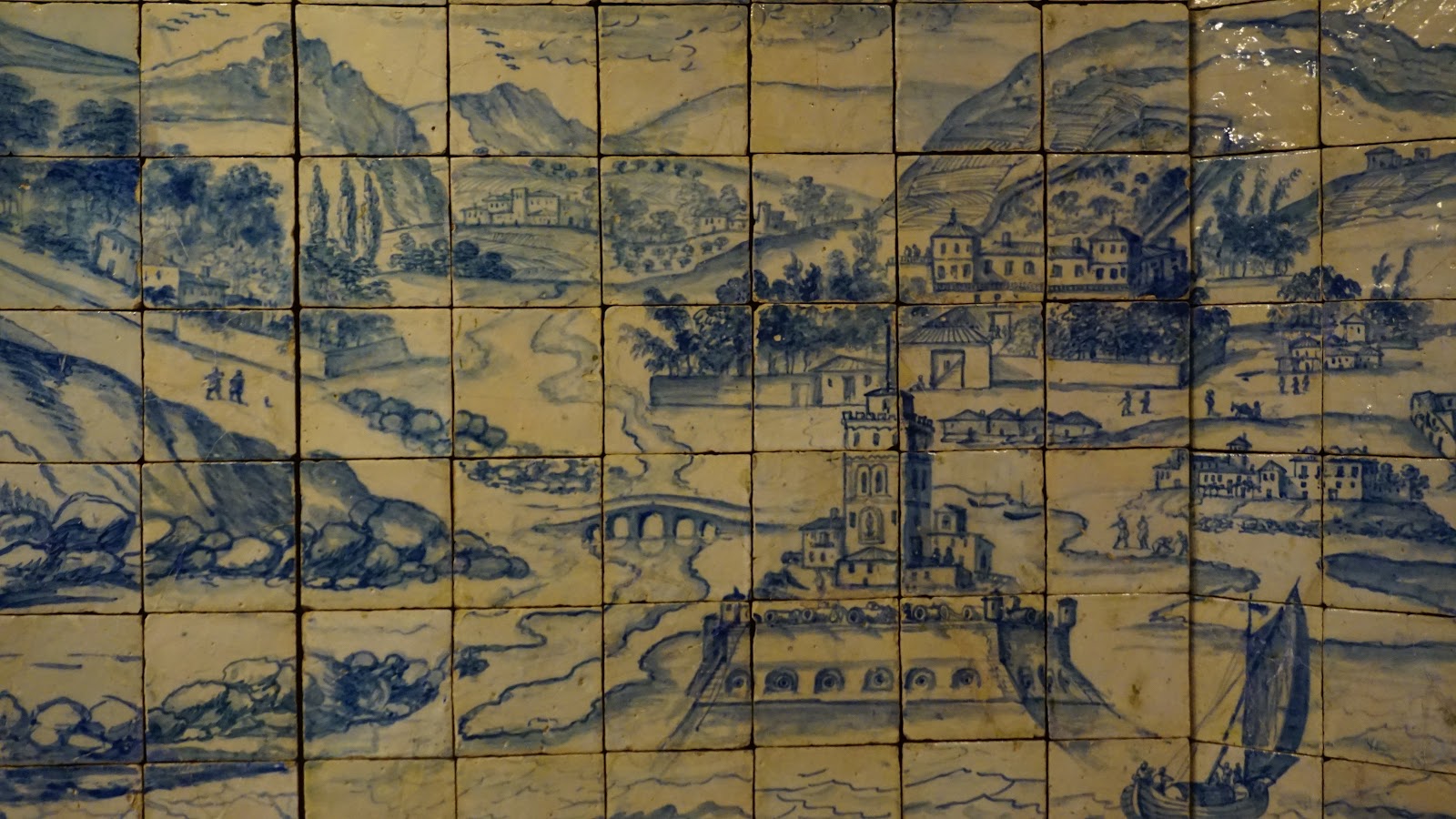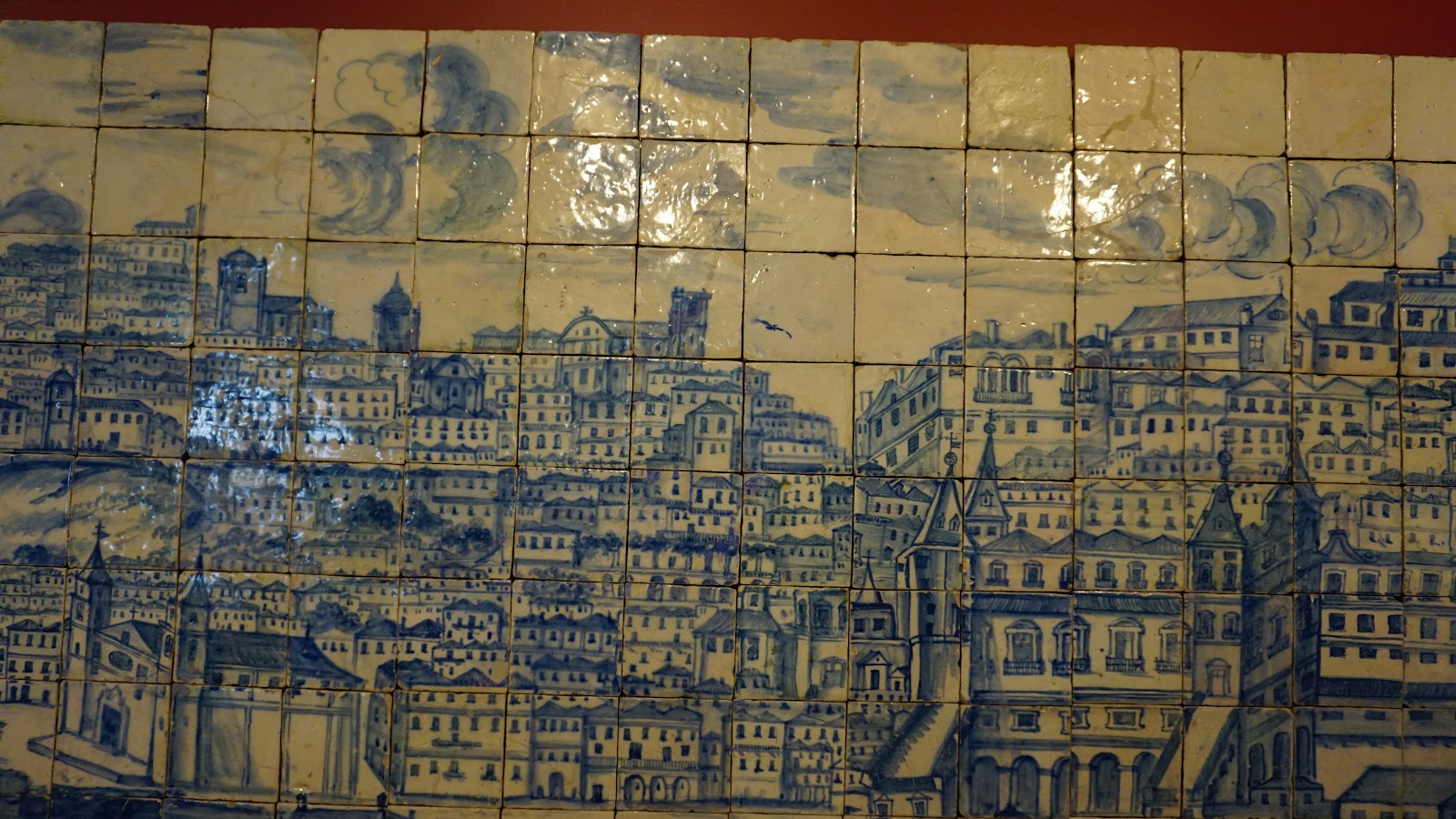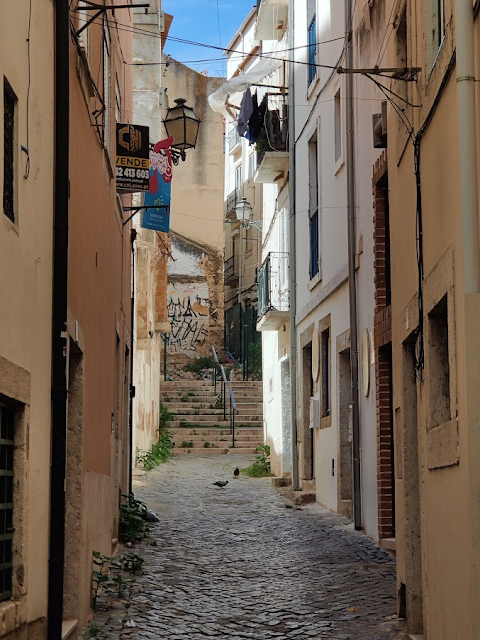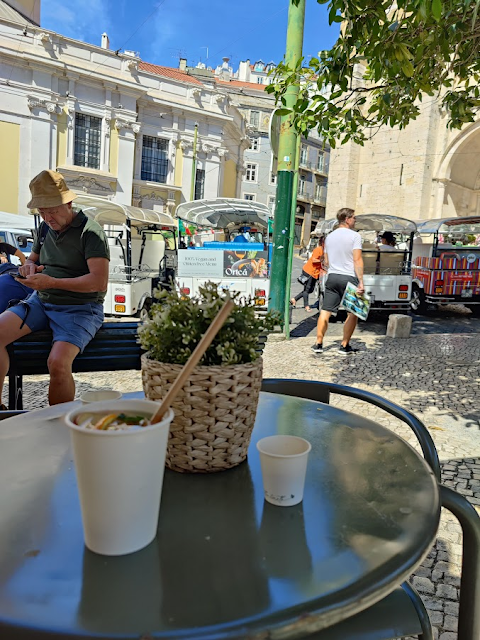National Museum of Azulejos.
Started the day pretty lazily, got out of the apartment after 11am. Getting to the Tile Museum is a bit tricky - it is located in a somewhat off-the-beaten path place along the Tejo river. At the end, decided to take the most direct approach - metro to Arroios, then from there (Praca de Chile) - waited for about 10 minutes for a bus to take it. The way turned out to be relatively smooth - I wasn't certain if we'd climb a huge hill before dropping down to the river level, but the climb was pretty smooth - Arroios, apparently, is pretty high up. The descent was indeed rather steep though.
The museum of Tile is located in the old Convent of Madre de Deus, which boasts the standard convent architecture with the church, the cloisters, etc... The exposition starts by telling us of the techniques for making the tiles (there are apparently four or five different ones, developed at different times), shows some examples, and then walks us through two stories worth of tile art as it progressed from the 1500s, when they started making the tiles in Portugal, all the way into the 21st century. I took a lot of pictures.
One of the oldest tiles on display.
The globe of Portugal. I expected a lot of examples of it throughout the museum, but this wound up being nearly the only one.
Three-color tiles.
Our cat, Витька-зараза, as imagined by the 16th century azulejo masters.
18th century tile pannos. This one is called "The Dance Lesson".
My favorite. Someone is getting an injection in their butt.
One of the more impressive part of the museum is the fact that their archive of tiles appears to be many times the size of their actual collection.
The main cloister, with the storage rooms.
Part of the main cloister of the convent is the restoration rooms and the storage space for the tiles, easy to see from the cloister itself. I took several pictures of the restoration space, the storage, and some individual artifacts that I saw.
A peek into the storage space.
Cleanup and restauration work in progress. These look like 16th century tiles.
A cool plate waiting its turn to be restored.
Some of the tile storage crates.
Panoramic view of the storage/restoration space.
Another interesting part of the museum is the convent's church - all in gold and paintings. From the first floor, the church itself is accessible, and it has a lot going on - hard to capture individual detail over the immense amount of detail.
Igreja da Madre de Deus.
The Church's ceiling has some 20 paintings on it.
Church, view from the altar.
Even more impressive is the chior, which can be accessed from the second floor of the museum.
Church, view from the chior.
The entire choir is surrounded by paintings and Saint relics. Most of the relics are benign, but the one pictured below is a full frigging skull.
A Saint relic in the chior.
The most impressive room in the museum is on the third floor, where there is a 22-meter long installation showing about 14 km of the river Tejo coastline right before the 1755 earthquake destroyed Lisbon.
I took the pictures of the entirety of the installation, here are some fragments.
The 18th century immigrant quarters (where the kiln smokes are).
Center, where Praca de Commerca is right now. St. George's castle at the top.
More of the Center, with the Cathedral.
Convento do Madre da Deus.
After spending about an hour and a half to two hours at the museum, we left and decided to walk to the center. This is where the seclusion and inconvenience of this location reared its face. From the museum to the St. Apolonia station is about a 25 min walk, but it is a walk along the most boring streets, with no people and no commerce around. Some places look over the river and all the industry that is srtretched along it.
Approaching Santa Apolonia station (in red), and a view of the cruise piers.
The cruise ships were in - we saw two big ones docked just past the Santa Appolina station.
Some welcoming street art along the way.
The iconic Santa Apolonia station.
Past the Santa Apolonia station, things got more fun. We circled around the military museum, and got to the square in front of the Fado Museum, where we discovered Alfama in its best, with a lady selling homebrewed ginja called "Ginjinha da Olga", which we of course could not skip. The ginja itself was sweeter than other ginjas I tried. We bought a small bottle, but if we ever wind up in the same place, we might buy a bigger one.
From there, we took a scenic route towards Se de Lisboa through the lower Alfama district - we've not been to this part of town in previous visits, always, curving from the Lisbon Cathedral up towards the St. George's castle. Turns out, the lower Alfama is the place to be - lost of narrow streets, shops, restaurants, ginja tasting (saw at least one more homebrew ginja stall - this one had bottles with no labels at all), and some dudes offering hashish (which I politely refused).
Eventually, we came out of the Alfama's labyrinthine streets to the Se de Lisboa square, full of people and tuk-tuks. The Cathedral itself was closed, but we sat for a bit on the square in a small outdoors cafe that served its coffee and sangria (white, not fizzy, but cold and refreshing) in paper cups.
We then strolled down to Baxia, where we stopped for a few minutes at a Dutch fried potatoes place, and had some fried potatoes (my first meal of the day). Mine were with piri-piri mayo, Olga chose cocktail sauce flavored mayo.
Potatoes with piri-piri mayo and crunchy onions.
I also had some beer - drinkable but nothing special.
I ate, and I am content now.
We then turned towards our home, but on the way, I stopped by at two Grafferia Nacional - Lisbon's fancy wine/liquor - stores. I was looking for something interesting to buy. In the second store, I got a couple of white wines for Olga and Tanya (one - from Obidos). Both stores also had some very old and dirty port bottles on somewhat of a sale. In the second store I spotted Warre's port for 24 Euros, and decided to give it a go.
Warre's fine mature Tawny Porto - who knows how long it's been sitting on their shelves.
(I just looked up - the Grafferia Nacional web page suggests that this port was bottled in 1960s, there is also
this note from master of malt). So... 60 years in a bottle.
At home, we decided to cook the dinner. We had bought large Argentinian shrimp a couple days back, I boiled it in water. Also made Cascais-style (with red pepper) octopus salad. Tanya cooked potatoes, sausages and made salad.
Called it a night shortly after, while sitting outside on the balcony.
Night view from our balcony.
Steps. 13,942 steps according to the phone. The watch had around 12,500 steps.
Alcohol. A few things to report on.
Ginjinha da Olga. Obvious highlight of the day. As mentioned, sweeter and more syrupy than other ginjihas I tried. But tasted good. Olga liked the idea of Ginjinha da Olga too.
Beer. A simple lager bought in the fried potato place in Baixa. Fits well with the fried potatoes, but nothing special.
Sangria. A sangria in a paper cup is a radical idea, but it was good. The cup was too small though for a 4.45 Euro price.
Warre's fine mature porto. Another highlight of the day. Grafferia Nacional was on the quest to get rid of their old, single, badly looking bottles, so I suspect all of them were discounted, although they still were in the 25 - 45 Euro range. I took the chance on the cheapest I could find - it cost 24.90, and I am happy to report that the gamble paid off. I don't know how much aging to expect from a non-vintage wine, but given that I am looking at a bottle that was poured 60 years ago, with a cork that disintegrated upon an attempt to open it, the port itself is quite good. It is almost amber, not tawny, but it is smooth, sweet, and easy drinking. I've been drinking it for a few days now. It is not as sweet as the Largima white. Overall, I am happy with my gamble.
Warre's Fine Mature Tawny porto from the 1960s.
Next. Belem.
















